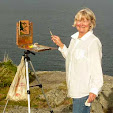Edisto Marsh Sky
5"x7" oil on gessobord
5"x7" oil on gessobord
Have you noticed that part of the enjoyment of starting a new project is researching and buying some new tools? I'm not saying that's a bad thing. A new project means learning something new, and in my experience that's pretty attractive to most people. And we all know how hard it is to build something without good tools, so sometimes it takes a couple of passes to get the right ones.
Dinghies
12"x12" oil on gessobord
There are a number of mediums available for making paintings; oil, acrylic, water color, etc. And in any given medium, there's more than one way to apply the paint. Remember finger painting? I'm not going to try that with my oil paints...
Tidal River Reflection
5"x7" oil on gessobord
Most oil paintings are made using brushes. But painting knives are also used, in a process that's somewhat like frosting a cake. I've tried painting with knives a couple of times over the years. I like the way the paintings look, there's a lot of texture. And I like the looseness I can achieve with a knife. The lack of need for solvent and the way the knives clean up with a wet wipe is also very appealing. You know I'm always looking at ways to make things easier.
What I didn't know when I tried knives the first time is that painting on an easel isn't the best way. To paint with a knife you need to be able to move your hand around the surface of the painting from all directions, and that's much easier to do on a table or with a jig in your lap. And fortunately I had one.
Looking over my shoulder as I create the above painting
using the jig that holds the painting in place on my lap
So the new tools needed to paint with a knife are of course, knives. Painting knives have three important characteristics; size, shape, and flexibility. The size and shape you need are determined by the area you want to paint with a given color, and it takes some practice to figure that out. I like pretty stiff knives, but I may go for the softer ones as I get better at it. The other tool you need is a jig to hold the painting, so you can turn it around to slide the paint in your direction of choice. It also helps to keep the paint from getting all over you!
Stay tuned, this summer I'm going for plein air knife paintings of boats.









